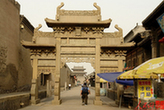In ancient times, Lianyungang City of Jiangsu Province was called Haizhou. Gongdiao of Haizhou refers to an art form of singing in successive tunes, which is popular in Lianyungang City and its surrounding areas. It comprises several basic tune-patterns including [Ruanping], [Dieluo], [Lidiao], [Nandiao], and [Boyang]. It is an art form sang by Qupai Cluster.
With a long history, Five Gongdiao of Haizhou is an important school of popular music in Jiangsu during the Ming and Qing Dynasties. As precious remains of antique "Zhugongdiao" (literally omniform tunes), it is of significant demonstrative value in studying Chinese folk music and even folk operas. It has been a long tradition for people in Haizhou to sing ditties. Not only do Jiangsu and Shandong Provinces converge in Haizhou, but the local dialects of Yangtze-Huaihe Valley and North China also intersect here. Therefore, in history, ditties and tunes in both the South and North China were rooted and spread here. They were on the one hand coexisting and on the other hand interacting. By the reign of Jialong in the Ming Dynasty, Five Gongdiao of Haizhou had basically taken shape.
Traditional Chinese music theory has generalized the logical relations between tones, notes and modes, thus clarifying the primary theory about tonality. Ever since the twelve-tone theory was proposed by royal musicians in the Zhou Dynasty, the mode theory of Chinese music has always been based on the twelve-tone system. There is no such specific term as "music scale" in traditional music theory. The term of music scale is usually expressed from varied perspectives, by using concepts like sound, temperament, note and mode. A certain music scale (sound) is graded into several degrees (notes) which correspond respectively to certain temperaments. The degrees are interrelated according to certain rules. The name of a music scale is called gong. There is a subordinative relationship between gong and the mode. Coming first in a music scale, the note of gong, based on a certain note (music degree), forms a certain mode. In the subsequent theatric works, terms like gong, mode, and tune were often conceptually interchanged, thus losing their original meanings. Afterwards, theatric music began to indicate its gong and mode by turning to the seven-mode system of folk flute music, as well as the concluding mode of a music book. In the music books spread among people, there are modes like "Xiaogong Mode" (similar to D major) and "Fanzi Mode" (similar to E flat major).
With a long history, Five Gongdiao of Haizhou boasts an accumulative and substantial content. Some ditties have been constantly evolved and passed down from the Ming Dynasty, such as Jishengcao, Shanpoyang, and Dazaogan. Yet they still remain intact. Moreover, in Jiangsu and Zhejiang, there are tunes like Matoudiao which are on the verge of extinction. However, heirs to such tunes can also be found in Haizhou, whose librettos are almost identical with those recorded in Baixue Yiyin (a collection of folk songs edited in the middle Qing Dynasty). Besides, some difficult compound songs are still performed and disseminated here.





Why not rent a boyfriend, or girlfriend to please parents during the Spring Festival?